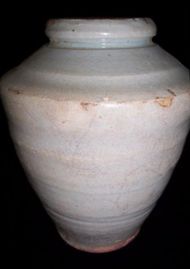Antique Pottery and Porcelain of China
A Definition of Chinese Ceramics
Due to a wealth of different ceramics created throughout the ages, the
line between porcelain and other types of pottery is often unclear in China itself, the
origin of porcelain. The Chinese term (Ciqi) that actually means porcelain is
often used indisciminately for both china porcelain and pottery items like earthenware, including for those that are really early predecessors of real porcelain.
Chinese ceramics mainly are separated into two groups, earthenware pottery and porcelain. The concept of stoneware appears to be of European origin and is not used with Chinese ceramics, normally. Stoneware is usually included with porcelain. The concept of soft-paste porcelain is foreign to Chinese ceramics.
Below
is a clear definition from a Chinese source to what should be
considered porcelain and what is earthenware among Chinese antique ceramics.
|
Needless to say that when speaking of Chinese ceramics the terms used for "porcelain" and "earthenware" are frequently used in a way that the
border between the two is muddled. |
 Glazed Ming storage jar |
Tang Sancai or other early Sancai wares were often made with white clay, but they were fired at lower temperatures than normal porcelain. Therefore, it is doubtful whether they should fall into the porcelain or the earthenware category, below.
Some of the green/greenish glazed pottery wares (Celadon) are also
frequently called porcelain in Chinese, though they are really glazed earthenware. Then there are Longquan ceramics which are
categorized as porcelain but actually have a light gray clay body -
normally, that is. There are also Longquan items with a snow white clay body.
The clay color would usually usually have been defined by (1) the color of the locally
mined clay and, (2) the degree to which the clay was refined
(impurities removed). Iron content would make a clay gray.
Some collectors use a simple way of categorizing ceramics: any ceramic
body of high density with a high ringing tone is classified as
porcelain. However, this is a bit too simplified a definition, it would appear.
Differences between earthenware and porcelain
| Other Pottery | Porcelain | |
| Material | normal clay | Kaolin (china clay) |
| Color | red, brown, gray | white |
| Firing temperature | 600-800° | 1200° or more |
| Properties | relatively porous & soft | non-porous, hard & strong |
| Tapping sound | dull sound | clear ring |
| Water absorbtion | high | very low or none |
| Body | non-transparent | semi-transparent |
| Characteristics | low chemical & mechanical resistance | high chemical & mechanical resistance |
* This definition may differ in Europe due to the existence of "soft paste" porcelain, bone china and different clays prior to the discovery of Kaolin.
Ceramic separation by age, in China
Worth mentioning here is a separation of ceramics according to age. In
China many collectors make a difference between so-called early or
"ancient" ceramics and later or "antique" ceramics. Normally, ancient
ceramics refers to those before and including the Song/Yuan dynasties.
But, most collectors will include underglaze blue/underglaze red
ceramics from the Yuan dynasty in the category of the later ceramics.
The latter usually includes Ming and Qing dynasty, and early republic
ceramics. Thus the Yuan dynasty ceramics are the limit for either, but
it depends really on the type of porcelain. This all despite the proven
existence of porcelain even earlier.
Addition:
Archaeologic proof shows blue and white ceramics as early as the Tang and Song dynasties, whereas the blue pigment and manufactuing method may have been different. Most proof comes from shards as few complete items are extant.
The actual time of discovery/development of real porcelain is
not quite clear, but Kaolin seems to have been in use since at least the
Tang dynasty.
Experienced Chinese collectors often specialize in either the
ancient ceramics or the later porcelain as mentioned above. They feel that the field of knowledge required in
Chinese ceramics is much too broad to allow for expertise in all.
Separation according to 'plain' and 'decorated' ceramics
Sometimes ceramics are separated in yet another way, namely by periods of plain and decorated ceramics.
The
time before the Ming dynasty is called the 'plain ceramics period',
while the Ming and Qing dynasties and later is called the 'decorated
ceramics period'.
Before the Ming dynasty the majority of ceramics
had no color decoration painted either under or on top of the glaze,
thus they are called 'plain'.
